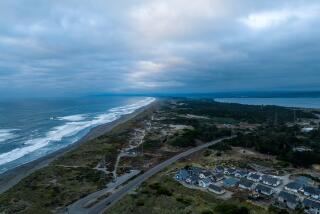Other Cities Finding San Diego a Good Spot to Angle for Tourists
- Share via
Several years ago the San Diego Convention and Visitors Bureau (ConVis), recognizing the benefits of tourism, launched a marketing campaign that helped make “America’s Finest City” one of the most popular vacation centers in the nation.
The campaign worked. Millions of tourists visit San Diego each year and, according to ConVis statistics, 70% of the tourists interviewed in a countywide study said they planned to return for future vacations. But will they?
Trying to capitalize on San Diego’s success, other cities have taken to advertising in San Diego, hoping to attract some of its 14 million tourists their way next year, said Lucy Warren, ConVis’ research director.
It smacks of Burger King walking into McDonald’s and yelling, “Come on over and try MY burgers.”
The scenario is all too familiar to ConVis officials, who say the recent advertising assault on San Diego by other locales is “a little unsettling.”
Competitive markets in other parts of the country--many of them newcomers in the tourist industry--are spend
ing bundles of money to attract tourist dollars. And San Diego, which itself spends $1.4 million annually to promote the city, is being inundated with advertisements promoting other areas, such as the 15 billboards touting Pittsburgh as the most livable city in America, the sprawling “Barizona” signs extolling Arizona’s climate, and the boards enticing San Diegans to “feel 21 again” by visiting Las Vegas.
Tourism is big business--one of the world’s largest, according to the Travel Data Center in Washington--and national statistics indicate that it is about to get even bigger.
For San Diego, tourism is the third largest industry after manufacturing and defense. And according to ConVis officials, the tourist trade is closing in on the No. 2 spot.
Terry Cahill, ConVis marketing director, said he expects tourist spending to increase by 7% to 8% this year. Inflation will account for part of that increase but, overall, the tourist trade is expected to outdistance the general economy, Cahill said.
ConVis officials had a taste of fierce competition during the Los Angeles Olympic Games last year, when the city experienced the slowest summer vacation season in 10 years. San Diego attempted to promote the city as a place to get away from the Olympic crowds, but vacationers steered clear of the area.
Daily attendance figures at Sea World and the San Diego Zoo plummeted, harbor excursions and the Gray Line Tours charter service reported a 20% drop in customers, and hotel and motel occupancy rates dipped 10% to 20% from the previous year.
“We were scared for a while there,” Cahill said. “We just hope we never see a period like that again.”
San Diego has since recovered from what tourism officials call the “Olympic drought,” but they fear that the scenario could be repeated if other cities are able to lure tourists away.
Cahill said the recent increase in competition has not affected San Diego’s tourist trade yet. But he suspects that competition might hinder future growth.
“States (and cities) that never had advertising budgets are suddenly springing to life with advertising campaigns,” Cahill said.
San Francisco just concluded a three-month advertising campaign in San Diego targeted at the leisure traveler. In the past, the city has focused primarily on the meeting and convention trade. But now that its Moscone Convention Center boasts a 94% occupancy rate, city officials e are trying to lure vacationers to visit “San Francisco this summer.” ConVis officials fear they will take heed.
Even San Diego is going to greater lengths to promote itself. Earlier this year, ConVis sponsored a multimedia road show that included a 10-minute aerobic dance skit and hors d’oeuvres of fresh fruit and juices.
The bureau is sponsoring a series of radio contests, including one in Fresno in which contestants can win an all-expense-paid trip to San Diego if they provide the winning name for the radio station’s news helicopter.
“The competitors are forcing us to be more aggressive in our advertising,” Cahill said.
What really has ConVis officials worried is the economy. San Diego is such a strong tourist center that shifts in the economy have not had a great effect on the city’s tourist trade in the past, Warren said. But increasing competition could change all that.
“When the economy falters and we are competing for a smaller piece of pie, then we might really start to feel a crunch,” Cahill said.
“It’s about to become a tougher ballgame.”
More to Read
Sign up for The Wild
We’ll help you find the best places to hike, bike and run, as well as the perfect silent spots for meditation and yoga.
You may occasionally receive promotional content from the Los Angeles Times.






